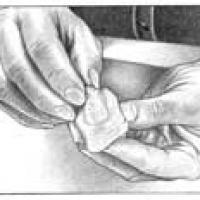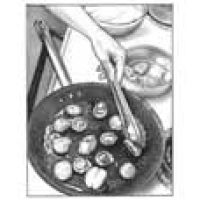ANGEL HAIR PASTA WITH SEARED SCALLOPS
From choclytcandy 15 years agoIngredients
- scallops shopping list
- 1 1/2 pounds sea scallops , about 30 to a pound, small side muscles removed (see illustration below) shopping list
- 1 1/2 tablespoons unsalted butter or olive oil shopping list
- pasta and Remaining Ingredients shopping list
- 1 medium shallot , minced shopping list
- 1 1/2 ounces fresh ginger , peeled, sliced thin, and julienned shopping list
- 1 pound angel hair pasta shopping list
- 2/3 cup dry white wine shopping list
- 2 tablespoons white wine vinegar shopping list
- 1 cup heavy cream shopping list
- 1/2 teaspoon table salt shopping list
- 1/8 teaspoon ground black pepper shopping list
- 1/4 cup finely chopped chives , or 1/2 cup chopped scallion greens shopping list
- 2 plum tomatoes , peeled, seeded, and diced (optional) shopping list
How to make it
- Note: This recipe was developed for a standard sea scallop, about the size of a short, squat marshmallow. If using smaller scallops, turn off the heat as soon as you turn them; they will finish cooking from the residual heat, fifteen to thirty seconds longer. For very large scallops, turn the heat to low once they have browned and continue cooking for one minute. Turn the scallops, raise the heat to medium, and cook them at least two minutes on the second side. The only tricky part of this recipe is ensuring that the pasta and sauce are done at the same time. Start the pasta after adding the ginger and shallots to the sauté pan and you'll be fine.
- 1. Bring water to boil in large pot; heat oven to 200 degrees for keeping scallops warm.
- 2. Sprinkle scallops on both sides with salt and pepper. Heat large (11-inch) sauté pan over medium-high heat until hot, about 1 minute. Add half the butter; swirl to coat bottom. Continue to heat pan until butter begins to turn golden brown. Add half the scallops, one at a time, flat side down; cook, adjusting heat as necessary to prevent fat from burning, until scallops are well browned, 1 1/2 to 2 minutes. Using tongs, turn scallops, one at a time; cook until medium-rare (sides firmed up and all but middle third of scallop opaque), 30 seconds to 1 1/2 minutes longer, depending on size. Repeat cooking process using remaining half of butter and scallops. Transfer scallops to heatproof plate and then to warm oven with door ajar.
- 3. Return skillet to burner; reduce heat to low. Add shallot and ginger; cook until shallot softens slightly, 1 to 2 minutes. (Add pasta to pot of boiling water.) Increase heat to high; add wine and vinegar and boil, scraping pan bottom with wooden spoon to loosen caramelized bits, until liquid reduces to a glaze, 4 to 5 minutes. Add cream, salt, and pepper; bring to boil. Reduce heat; simmer until cream reduces very slightly, about 1 minute longer. Stir in chives or scallions, and tomatoes if desired. Drain pasta; pour into large bowl. Add sauce; toss to coat.
- 4. Divide pasta among individual serving plates, arranging a portion of scallops around or on top of each. Serve immediately.
- Note: Removing the Muscle From the Scallop The small, rough-textured, crescent-shaped muscle that attaches the scallop to the shell is often not removed during processing. You can readily remove any muscles that are still attached. If you do not, they will toughen slightly during cooking.
- Sautéing Scallops When sautéing scallops, make sure not to overcrowd the skillet or they will not brown properly. Use tongs to turn the scallops in the sauté pan.
People Who Like This Dish 3
- JABNJENN Nowhere, Us
- elgourmand Apia, WS
- boosan21 Pleasant Valley, CT
- choclytcandy Dallas, Dallas
- Show up here?Review or Bookmark it! ✔
The Rating
Reviewed by 2 people-
Whoa, a great recipe. Glad the tomatoes are optional as that feels like it would be a flavor conflict. Great instructions. I am really looking forward to fixin this. Got to wait until I can get some scallops sent in. My compliments to who ever did th...more
 elgourmand
in Apia loved it
elgourmand
in Apia loved it
The Groups
- Not added to any groups yet!



Reviews & Comments 1
-
All Comments
-
Your Comments
" It was excellent "